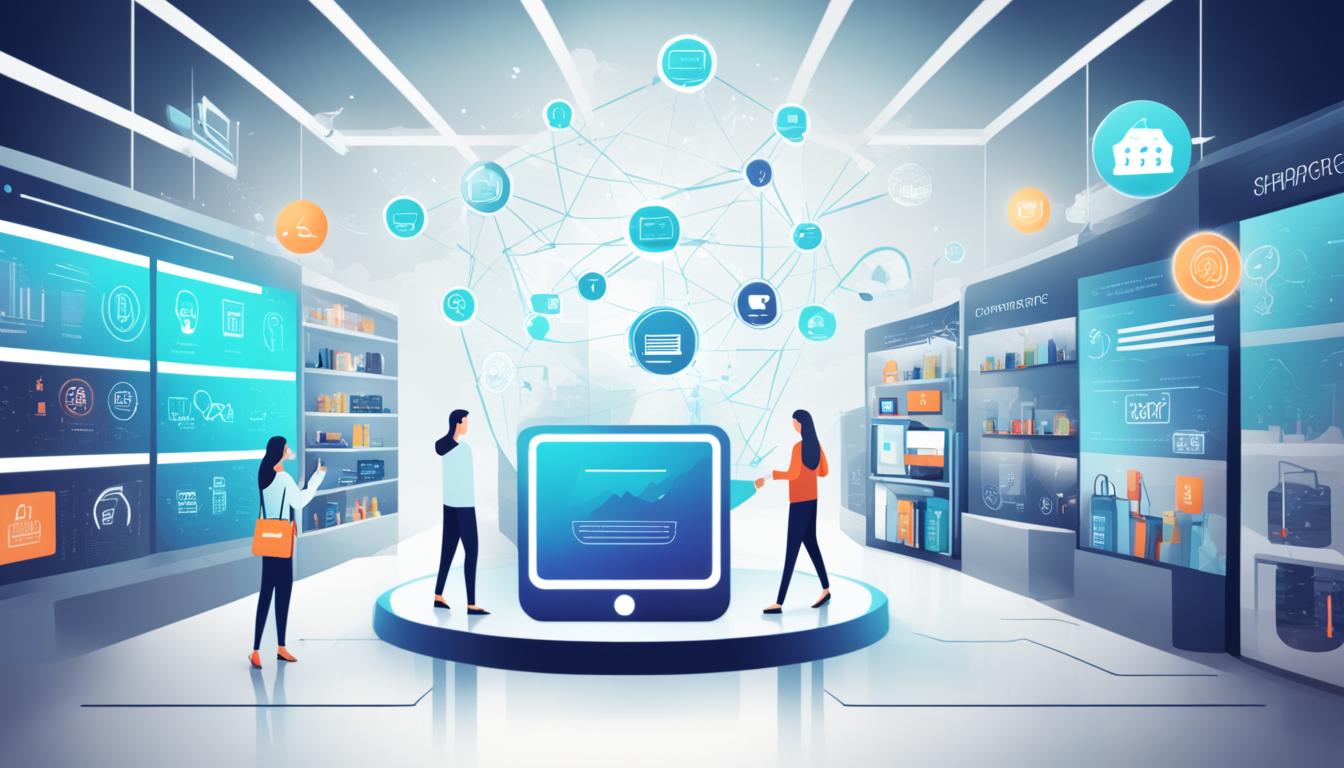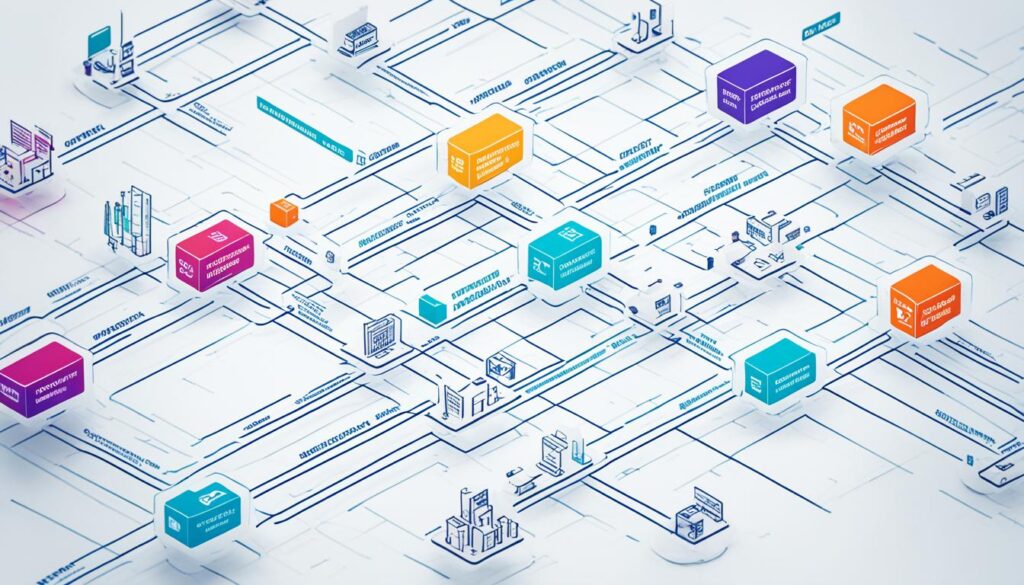Physical Address
304 North Cardinal St.
Dorchester Center, MA 02124
Physical Address
304 North Cardinal St.
Dorchester Center, MA 02124

Explore the cutting-edge Top 10 E-commerce Trends in 2024, from personalized shopping experiences to seamless omnichannel integration and sustainable practices.
The way we shop online is changing. New tech and what we like are making big changes to the e-commerce world. In 2024, shopping on the web will get a big update thanks to new trends. These include cool ways to try stuff with augmented reality, better ways to check on where products come from using blockchain, how companies keep you coming back with special rewards, and finding greener ways to sell things. It’s all about staying on top to beat the competition.
Augmented reality (AR) has changed how we shop online, bringing the store to our homes. Shoppers can see products as if they’re right in front of them. This makes choosing what to buy easier. Stores selling furniture and home goods are really making use of this new way to shop.
Research by Salesforce found that AR can reduce the number of things people send back by 14%. This is because with AR, people can try things out virtually before they buy. It allows customers to see how items would look in their space. This leads to fewer wrong purchases and happier customers.
Ikea’s app lets you see how furniture fits your home using AR. It’s a smart use of new tech that’s here to stay. As AR tech gets more common and cheaper, more stores will offer this kind of shopping. It’s making buying furniture and home items more interactive and fun.
Blockchain tech isn’t all about cryptocurrency and NFTs. It offers much more. For instance, in an e-commerce world, a blockchain acts like a never-ending book of data. It’s always being added to but never loses past records.
Logistics firms see a big plus in using blockchain. It brings a clear look at shipping for their clients. This includes updates like restocking and shipment details. The tech doesn’t just help the firms but also the clients’ customers by offering current data.
A blockchain ledger in shipping and logistics brings a new level of visibility. All actions and shipment data go on the blockchain, providing a complete and honest view. This openness works to earn trust, better talks, and make the whole logistics system smoother.
When blockchain clears the air, end-customers also win. They can see exactly where their orders are and when they’ll arrive. This helps them plan restocking and manage stock better. The result? Happier customers with less wait time.
| Blockchain Benefits for E-commerce Supply Chains | Impact |
|---|---|
| Append-Only Ledger for Shipping and Logistics | Increased transparency, trust, and communication between logistics providers and clients |
| Real-Time Updates and Restocking | Improved customer satisfaction and inventory management through access to shipment status and delivery information |
| Secure and Tamper-Proof Data | Reduced risk of fraud, counterfeiting, and errors in the supply chain |
| Automated Smart Contracts | Streamlined logistics operations and enhanced efficiency through self-executing agreements |
Blockchain boosts e-commerce by making the supply chain clearer and smoother. As more businesses use it, we’ll get an e-commerce world with better trust, efficiency, and new ideas.

From 2024 on, you can expect big changes in how online shops work. This year, personalization will really take off. Thanks to data analytics and AI, shops will get much better at offering you what you like. They’ll let you tweak loyalty programs to your shopping style. This means you’ll feel a closer bond with your favorite brands.
By using data analytics and AI, online stores will learn a lot about you. They’ll know what you prefer, when you like to buy, and what makes you happy when shopping. This info will help stores create loyalty programs that truly fit you. You’ll get rewards and deals that match just how you shop. This won’t just make you happier – it’ll also make you want to keep coming back. That’s what makes you valuable to your favorite brands.
Personalization in 2024 isn’t just about products or loyalty. Stores will aim to create experiences that really touch your heart. They might send you messages or offers that show they really know and appreciate you. By making you feel special, stores hope to win your lasting loyalty and even your public support.
The focus on sustainability and eco-friendliness is growing fast. By 2024, this focus will get even stronger in the e-commerce world. People want e-shops to offer eco-friendly choices, decrease waste from packaging, and use sustainable practices. Sellers need to follow these ideas to do better and stand out.
Buyers who care about the planet are making e-shops more green. About 60% of them would pay extra for things in sustainable packaging. To match this, sellers should put money into eco-friendly packing. This move could help the sustainable packaging field grow to $440.3 billion by 2025.
Mobile shopping is also growing, with 60% of it happening on phones in 2023. This is a chance for e-sellers to be more green. They can cut down on delivery pollution by using better routes and cleaner fuel. Since there might be 36% more delivery trucks by 2030, finding green delivery ways is really important now.
The wish for eco-friendly online shopping keeps rising. Companies that get on board with sustainable practices should do well. When e-shops and their buyers care about the same green things, trust and love for the brand grow. This could push these companies out in front in the world of eco-friendly online shopping.
| Key Statistic | Significance for Eco-Friendly E-Commerce |
|---|---|
| 60% of online shoppers are willing to pay more for products with sustainable packaging | Highlights the growing demand for eco-friendly packaging solutions among e-commerce consumers |
| The sustainable packaging market is projected to reach $440.3 billion by 2025 | Indicates the substantial growth and investment in sustainable packaging technologies and materials for the e-commerce industry |
| By 2030, the number of delivery vehicles is expected to increase by 36%, reaching around 7.2 million vehicles | Highlights the need for eco-friendly delivery solutions to mitigate the environmental impact of the e-commerce industry’s expanding logistics and transportation |

In 2024, people will look for e-commerce sites that keep their data security as a top priority. Privacy is more important than ever, pushing governments to make strict rules about how companies handle and protect customer info. For shoppers to feel safe, stores need to use top-notch security technologies and be very open about how they protect data.
Today, shoppers are careful about who they give their info to. E-commerce stores that put data security and privacy first will do better. These sellers should tell customers clearly about their security and privacy rules. This builds consumer trust and helps e-commerce sites stand out.
E-commerce businesses need to step up their game for safety-conscious customers. This means using the latest security technologies. They can start with strong encryption, advanced authentication, and smart data handling. By being at the forefront of security tech, e-commerce sites show they’re serious about protecting data and privacy. This, in turn, boosts consumer trust in their services.
By 2024, e-commerce will see a rise in tailored subscription services. These offers will meet customer needs in terms of what they get, when, and how often. Such subscription models help keep customers coming back. They also provide a steady income for companies.
Companies are getting better at knowing what their customers want. In 2024, e-commerce will offer more personalized services. This includes customized personalization for subscriptions. Customers can pick what they receive and when they get it, based on their own needs. This approach builds stronger ties between companies and their customers. It also makes shopping a smooth experience.

Today, the world of e-commerce is changing fast. This makes it crucial for companies to invest in AI technology. AI tools can improve many parts of online shopping. They make shopping safer, customer service faster, and products more personal.
AI is changing how online stores write about products and improve their search ranking. It uses smart systems to create product descriptions. These descriptions are not just informative but also attract more buyers. By using AI’s ability to understand human language, it makes sure the product info hits home with online shoppers.
Generative AI is a new way for online shops to stand out. It can design unique landing pages and visuals for each customer. These designs can be as unique as the people viewing them. This not only makes shopping more personal but also helps stores beat their rivals with one-of-a-kind digital experiences.

Data is crucial for your business. It helps you know your customers better, improves your business insights, and measures success. But handling a lot of data is hard. Data management and data harmonization come to the rescue. They combine data from different places. This results in a complete look at your business activities.
Harmonized data lets you discover insights quickly. This leads to higher customer happiness and more sales. It also helps with using AI and automation. These technologies can make your marketing, serving, and selling smoother.
By merging data, you understand your operations, customer actions, and market changes better. This total view lets you make smarter choices. These decisions can boost growth and enhance your business’s overall performance.
Harmonized data is key for using advanced tech like AI and automation. It enables you to streamline tasks. You can customize how you deal with customers. Plus, it helps make your marketing and sales more effective.
Do you remember when talking to chatbots was boring and strange? That’s changed, all thanks to new technology and better AI. Conversational commerce has a whole new look. Now, asking questions or getting help with a service online feels more like chatting with a friend. This change makes online shopping friendlier and more personal, just like in a real store.
Talking naturally, using images, and letting data guide interactions makes finding products easier. Chatbots can answer questions like a friend, thanks to smarter AI. This makes it easier to shop online because the gap between people and technology is shrinking.
Now, chatbots can give recommendations that feel tailored just for you. They can also guess what you might want to buy next. This makes shopping online smoother and more fun. Plus, it keeps customers coming back for more.
In 2024, e-commerce is changing with many new trends. These trends include using augmented reality and blockchain more, better loyalty programs, and eco-friendly efforts. There’s also a focus on making things more secure for shoppers. This way, customers get shopping experiences that feel more personal, clear, and good for the world.
By 2030, the big market for personalization software is expected to be worth over $5 billion. It’s growing fast, at about 23.67% each year. Companies like Starbucks are already personalizing a lot of their orders. They use data about what customers like, where they are, and what they bought before to send messages. This shows how businesses are using data to make shopping more personal for people.
AI, augmented reality, and voice search are also changing how we shop online. They help businesses connect more with customers, make marketing better, and make shopping easier. As people care more about the planet and what brands stand for, online stores need to change too. They must offer things that are good for the earth and have clear values.
By following these new trends, e-commerce companies can be ready for the future. They can give great experiences to shoppers and grow their businesses in the coming years.